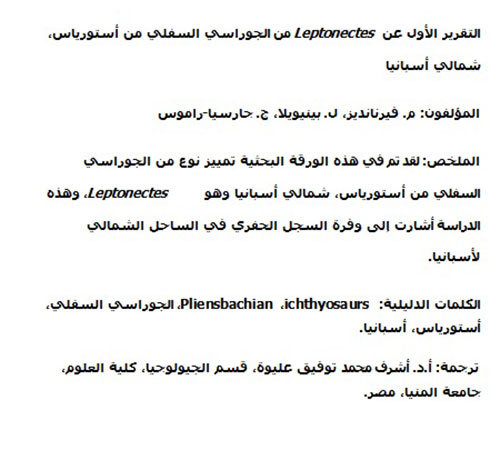First report of Leptonectes (Ichthyosauria: Leptonectidae) from the Lower Jurassic (Pliensbachian) of Asturias, northern Spain
Plain Language Abstract
During the Mesozoic several reptile lineages were main predators of the seas and oceans all over the world. Among them, advanced ichthyosaurs, with bodies strongly modified to a fish-shaped profile, represent the most extreme examples of adaptation to this pelagic life-style. Their evolutionary history spans from the Early Triassic up to the middle Late Cretaceous, but they are particularly well known through the Jurassic. However, some episodes of this long history are still obscure due to geographic and stratigraphic gaps in the fossil record. Early Jurassic ichthyosaurs are well known from several European localities including the famous southern England localities (i.e., Lyme Regis-Charmouth, Dorset and Street and surrounding areas, Somerset), the Holzmaden and surrounding areas (Germany), and Switzerland. Between these faunas, Pliensbachian ichthyosaurs are poorly documented and fossils from the Iberian Peninsula (Portugal and Spain) are almost unknown. Field trips undertaken by the scientific staff of the Museo del Jurásico de Asturias in recent years along the northern coast of Spain (Asturias) resulted in the discovery of significant remains corresponding to, at least, six different specimens. These discoveries highlight the fossil richness of the northern coast of Spain and suggest that the relatively low abundance of Pliensbachian ichthyosaurs worldwide may be due to incomplete and/or uneven sampling of Lower Jurassic localities.
Resumen en Español
Primer registro de Leptonectes (Ichthyosauria: Leptonectidae) del Jurásico inferior (Pliensbaquiense) de Asturias, norte de España
Los ictiosaurios del Jurásico temprano son bien conocidos sobre la base de los abundantes y exquisitamente preservados registros europeos del Tethys Oriental. Por ejemplo, las faunas del sur de Inglaterra y de Holzmaden y sus alrededores (Alemania) son conocidas en todo el mundo. Sin embargo, conectando ambas áreas, todavía hay hiatos y/o localidades de la costa norte de Europa que han sido sub-muestreadas. En los últimos años, como resultado de las exploraciones paleontológicas y geológicas sistemáticas de las localidades fosilíferas Plienbaquieneses a lo largo de la costa norte de Asturias (España), se han recuperado varios ejemplares de ictiosaurios. Uno de ellos pudo identificarse a niveles taxonómicos bajos y se lo refiere como Leptonectes sp. Estos nuevos hallazgos destacan la riqueza fosilífera de la costa norte de España y sugieren que la abundancia relativamente baja de ictiosaurios pliensbaquienses en todo el mundo puede haber sido subestimada.
Palabras clave: ictiosaurios; Pliensbaquiense; Jurásico Inferior; Asturias; España
Traducción: Authors
Résumé en Français
Première description de Leptonectes (Ichthyosauria : Leptonectidae) dans le Jurassique inférieur (Pliensbachien) des Asturies, nord de l’Espagne
Les ichthyosaures du Jurassique ancien sont bien connus d’après les nombreuses occurrences extrêmement bien préservées de la Téthys occidentale. Par exemple, les faunes du sud de l’Angleterre et les argiles à posidonies toarciennes d’Holzmaden et des zones environnantes (Allemagne) sont mondialement connues. Cependant, la côte septentrionale d’Europe présente toujours des lacunes et/ou des localités sous-échantillonnées entre ces zones. Ces dernières années, des spécimens d’ichthyosaures ont été collectés lors d’explorations géologiques et paléontologiques systématiques des localités fossilifères pliensbachiennes le long de la côte septentrionale des Asturies (Espagne). L’un de ces spécimens a pu être identifié à des niveaux taxinomiques plus bas et il est attribué à Leptonectes sp. Ces nouvelles découvertes soulignent la richesse du registre fossile de la côte septentrionale d’Espagne et suggèrent que l’abondance relativement basse mondialement des ichthyosaures pliensbachiens a peut-être été sous-estimée.
Mots-clés : ichthyosaures ; Pliensbachien ; Jurassique inférieur ; Asturies ; Espagne
Translator: Antoine Souron
Deutsche Zusammenfassung
Erster Nachweis von Leptonectes (Ichthyosauria: Leptonectidae) aus dem unteren Jura (Pliensbachium) von Asturien, Nordspanien
Frühe Ichthyosaurier sind sehr gut bekannt, da es zahlreiche und sehr gut erhaltene europäische Funde aus der westlichen Tethys gibt. Die Faunen aus Südengland und aus dem Posidonienschiefer von Holzmaden (Toarc) und umliegenden Gebieten in Deutschland sind weltweit bekannt. Allerdings gibt es zwischen diesen Gebieten immer noch Lücken und/oder Gegenden an der nördlichen Küste Europas mit nur wenigen Funden. Da die fossilreichen Gegenden entlang der Nordküste von Asturien (Spanien) aus dem Pliensbachium in den letzten Jahren systematisch paläontologisch und geologisch exploriert wurden, konnten Ichthyosaurier-Stücke gesammelt werden. Einer dieser Funde kann bis auf eine untere taxonomische Ebene bestimmt werden und wird Leptonectes sp. zugeschrieben. Diese neuen Funde unterstreichen die Fülle des Fossilberichts von der spanischen Nordküste und deuten darauf hin, dass die relativ geringen weltweiten Vorkommen von Ichthyosauriern aus dem Pliensbachium möglicherweise unterschätzt wurde.
Schlüsselwörter: Ichthyosaurier; Pliensbachium; Unterer Jura; Asturien; Spanien
Translator: Eva Gebauer
Arabic

Translator: Ashraf M.T. Elewa
Polski
Pierwsze doniesienie o Leptonectes (Ichthyosauria: Leptonectidae) z dolnej jury (pliensbach) w Asturii, północna Hiszpania
Wczesnojurajskie ichtiozaury są dobrze poznane z powodu bogatych i znakomicie zachowanych europejskich okazów z Zachodniej Tetydy. Przykładowo, fauna z południowej Anglii czy łupki z toarku w okolicach Holzmaden (Niemcy) są znane na całym świecie. Jednak pomiędzy tymi rejonami wciąż istnieją miejsca częściowo lub niezbadane, wśród obszary północnego wybrzeża Europy. W ostatnich latach, w wyniku systematycznych badań paleontologicznych i geologicznych na stanowiskach z pliensbachu, wzdłuż północnego wybrzeża Asturii (Hiszpania) zebrano okazy ichtiozaurów. Jeden z nich zidentyfikowano na niższym poziomie taksonomicznym i określono Leptonectes sp. Te nowe odkrycia podkreślają bogactwo zapisu skamieniałości północnego wybrzeża Hiszpanii i sugerują, że stosunkowo niska liczebność ichtiozaurów z pliensbachu na całym świecie mogła zostać niedoceniona.
Słowa kluczowe: ichtiozaury; Pliensbach; dolna jura; Asturia; Hiszpania
Translator: Dariusz Nowakowski

